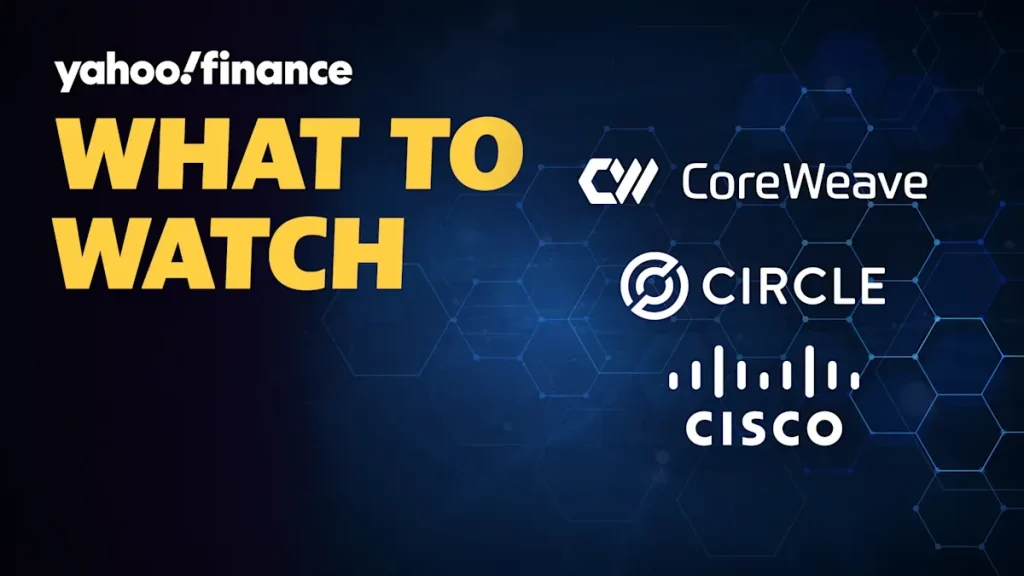CoreWeave earnings slid 9% in extended trading on Tuesday as investors weighed quarterly results from the provider, and the company faced questions about how quickly it can convert growth into sustainable profits. Revenue rose to $1.21 billion, surpassing the $1.08 billion consensus and signaling robust demand in the sector as the top line more than tripled from $395.4 million a year earlier. Yet the company posted a net loss of $290.5 million and an EPS loss of 21 cents, with margins squeezed by stock-based compensation. Debt totaling roughly $11.1 billion underscores the scale of CoreWeave’s expansion to boost capacity. Management highlighted an expanding OpenAI partnership to help fuel growth.
Seen from a different angle, the quarterly results illustrate how AI compute providers balance rapid top-line growth with ongoing cost discipline. Analysts describe the trend as a shift toward scalable cloud platforms that monetize capacity as utilization rises and supply catches up. The OpenAI collaboration sits at the center of the strategy, underscoring the importance of ecosystem wins for expanding customer deployments. Industry observers will monitor how revenue strength translates into durable earnings while managing debt and capital-intensive expansion.
CoreWeave earnings Snapshot: Revenue Surges but Loss Widens
CoreWeave reported a second-quarter revenue of $1.21 billion, topping Wall Street expectations, while posting a net loss of $290.5 million. The loss per share was 21 cents, and management noted that earnings per share were not directly comparable with the LSEG estimates. This combination of blockbuster top-line growth and a widening bottom line is a classic hallmark of a fast-scaling AI infrastructure provider navigating aggressive investment cycles.
The results underscore the market’s appetite for AI infrastructure services, with revenue more than tripling from $395.4 million a year earlier. However, the high operating costs, including roughly $145 million in stock-based compensation, pressured margins and highlighted the ongoing tension between rapid growth and profitability in the AI hardware space.
AI infrastructure Growth Fueled by Nvidia GPUs Rental Demand
CoreWeave operates at the nexus of AI infrastructure by renting Nvidia GPUs to customers, a model that has benefited from the surge in AI workloads and data center demand. The company competes with cloud providers like Amazon to supply GPU power for training and inference, positioning itself as a nimble alternative in the Nvidia GPUs rental market.
With demand outstripping supply, CoreWeave is pushing capacity expansion to support more AI training jobs and model deployments. This environment reinforces the AI infrastructure thesis that businesses need scalable, on-demand GPU resources to accelerate development pipelines and time-to-market for AI solutions.
OpenAI Partnership Expands CoreWeave’s Client Base
Management highlighted an expanding OpenAI partnership as a strategic driver, noting that OpenAI is a major client and investor. This relationship reinforces CoreWeave’s role in supporting cutting-edge AI research and production workloads through robust data center and GPU capacity.
The collaboration with OpenAI also signals potential downstream opportunities, as enterprise clients look to integrate OpenAI-powered models into their operations. The OpenAI partnership, alongside new banking clients like Goldman Sachs and Morgan Stanley, points to a growing ecosystem of AI-forward customers leveraging CoreWeave’s AI infrastructure and model-monitoring capabilities.
Data Center Expansion Plans: New Jersey Project and Capacity Growth
A centerpiece of CoreWeave’s growth plan is a data center expansion in New Jersey with up to 250 megawatts of capacity, slated for delivery in 2026. The project underscores the company’s commitment to scaling its AI infrastructure footprint to meet surging demand for GPU-backed compute.
This data center expansion complements a broader push to secure strategic locations for AI workloads and edge-to-core processing. As capacity expands, CoreWeave aims to improve throughput, reduce latency, and offer more flexible pricing and GPU rental terms to customers across industries.
CoreWeave stock Performance and Investor Outlook After Q2
The earnings release coincided with a mixed market reaction, as CoreWeave shares slid in after-hours trading despite beating revenue expectations. The stock has been volatile as investors assess the company’s growth trajectory, debt load, and margin dynamics within the AI infrastructure space.
Looking ahead, investors are weighing the topline expansion against rising leverage and ongoing operating costs. The combination of OpenAI partnerships, data center expansion, and a potential ramp in spot GPU rentals will shape the narrative for CoreWeave stock in the coming quarters.
Margins Under Pressure: Stock-Based Compensation and Rising Debt
CoreWeave’s operating margin dipped to 2% from 20% a year earlier, driven largely by substantial stock-based compensation costs of about $145 million. This emphasizes the cost structure challenges faced by high-growth AI infrastructure players as they scale the business.
Debt remains a dominant factor, with total borrowings at roughly $11.1 billion. The elevated debt load adds a layer of financial risk, even as revenue growth accelerates and the company invests in capacity, acquisitions, and partnerships to sustain its industry-leading AI platform.
Banks as Customers: Goldman Sachs and Morgan Stanley Join the Roster
In a notable development, CoreWeave’s conference call highlighted expanding client activity among financial services firms like Goldman Sachs and Morgan Stanley. These banks joining CoreWeave’s customer base aligns with a broader trend of AI-driven workloads across corporate treasuries and risk analytics operations.
The OpenAI partnership and increasing enterprise adoption imply that CoreWeave’s AI infrastructure is becoming integral to complex modeling and data processing tasks in regulated industries. This growth supports the company’s strategy to diversify revenues beyond hyperscale cloud providers.
Guidance for 2025: Raised Revenue Outlook and Q3 Targets
For the third quarter, CoreWeave guided revenue of approximately $1.26 billion to $1.30 billion, topping analyst expectations and signaling continued strength in AI workloads. This aligns with a broader forecast of steady demand for GPU-backed compute as enterprises scale AI initiatives.
The 2025 revenue outlook was raised to a range of $5.15 billion to $5.35 billion, representing a substantial growth trajectory. Analysts had expected about $5.05 billion, suggesting that management believes capacity expansion and OpenAI partnerships will translate into meaningful top-line gains.
IPO Journey and Market Debut: CoreWeave Stock on Nasdaq
CoreWeave went public in March, debuting on Nasdaq after pricing its offering and raising capital to support expansion. The share sale helped fund infrastructure investments and the rapid scaling of GPU-backed compute capacity.
As of the latest close, CoreWeave stock traded around $148.75, pushing the market capitalization above $72 billion. The post-IPO trajectory reflects investor optimism about AI infrastructure growth, data center expansion, and the potential upside from the OpenAI partnership and other strategic relationships.
Post-Acquisition Move: Weights & Biases Boosts AI Model Monitoring
In a strategic move, CoreWeave acquired Weights & Biases for $1.4 billion, acquiring software for monitoring and managing AI models. This acquisition signals an intensified push to offer end-to-end AI model management within its infrastructure platform.
Weighs & Biases enhances the company’s product suite for the OpenAI partnership and ongoing AI workloads, potentially improving model performance and governance. The move also illustrates how CoreWeave is expanding beyond raw GPU rental into a more comprehensive AI infrastructure stack for data-heavy workflows.
Frequently Asked Questions
What were CoreWeave earnings and revenue results, and how did CoreWeave stock react after hours?
CoreWeave earnings showed a loss per share of 21 cents with revenue of $1.21 billion, topping the $1.08 billion expected. Revenue more than tripled from the prior year, but the stock moved lower in extended trading as investors weighed the guidance and growth prospects for the AI infrastructure business.
How does CoreWeave’s data center expansion support its AI infrastructure growth strategy?
The data center expansion in New Jersey, with up to 250 megawatts of capacity planned for 2026, signals a scaling of CoreWeave’s AI infrastructure to meet rising demand for AI workloads and GPU capacity.
What impact does the OpenAI partnership have on CoreWeave earnings and customer growth?
The OpenAI partnership is highlighted as expanding CoreWeave’s business, positioning OpenAI as a major client and investor and contributing to revenue growth within the AI infrastructure ecosystem.
Why is Nvidia GPUs rental central to CoreWeave’s revenue, and how does it relate to AI infrastructure demand?
Nvidia GPUs rental is a core component of CoreWeave’s AI infrastructure offering, enabling customers to access high-performance GPUs for AI workloads. Strong demand for these GPUs supports revenue growth, even as competition with cloud providers intensifies.
What factors drove CoreWeave’s operating margin lower in the latest results?
CoreWeave’s operating margin fell to about 2% from 20% largely due to $145 million in stock-based compensation costs, which weighed on profitability despite rising revenue.
What does CoreWeave’s debt level indicate about its financial health and earnings trajectory?
With debt around $11.1 billion, CoreWeave faces leverage that can stress profitability and liquidity, making debt management and free cash flow important considerations for its earnings trajectory.
What is CoreWeave’s guidance for 2025 revenue and for the upcoming quarter?
Management sees 2025 revenue of approximately $5.15 billion to $5.35 billion, with third-quarter revenue guidance around $1.26 billion to $1.30 billion, reflecting continued growth in the AI infrastructure business.
How did CoreWeave’s IPO and initial stock performance frame investor sentiment about its AI infrastructure earnings?
CoreWeave’s Nasdaq debut raised about $1.5 billion, and the stock traded at elevated levels, signaling investor optimism about its AI infrastructure growth, despite ongoing losses and high investment in capacity.
In what ways does CoreWeave position itself against cloud providers in Nvidia GPUs rental?
CoreWeave competes with cloud providers like Amazon by offering Nvidia GPUs rental as part of its AI infrastructure platform, aiming to attract customers seeking scalable, GPU-powered AI solutions.
| Key Point | Details | Notes/Impact |
|---|---|---|
| Stock reaction | Shares slid 9% in extended trading after results and guidance beat expectations. | Market reaction to the earnings release. |
| Earnings vs estimates | EPS of -$0.21; Revenue of $1.21B vs $1.08B expected. | Revenue beat while EPS was negative. |
| Revenue growth (YoY) | Revenue more than tripled to $1.21B from $395.4M year earlier. | Indicates strong top-line growth. |
| Net income/loss | Net loss of $290.5M vs $323M loss a year earlier. | Loss narrowed year over year. |
| Profitability/margin | Operating margin at 2% vs 20% prior year; $145M stock-based compensation costs. | Margin compression due to SBC costs. |
| Debt | Debt at $11.1B. | High leverage level. |
| IPO/public status | Second quarter as a public company since March IPO. | New public-company phase. |
| Key client activity | Expansion with OpenAI; Goldman Sachs and Morgan Stanley become customers; banks were IPO underwriters. | Strategic client and bank relationships forming. |
| Acquisition | Acquired Weights & Biases for $1.4B. | Adds AI model monitoring capabilities. |
| May performance context | May highlighted 420% revenue growth with widening losses and nearly $9B debt. | Momentum exists amid debt concerns. |
| Guidance (near-term) | Q3 revenue guidance: $1.26B–$1.30B; 2025 revenue guidance: $5.15B–$5.35B (vs. $5.05B consensus) | Outlook improved vs previous ranges. |
| Public market details | Nasdaq debut after IPO; 37.5 shares sold at $40 each, yielding $1.5B; market cap >$72B as of Tuesday close. | IPO milestones and market positioning. |
| Expansion plans | New Jersey data center project up to 250 MW to be delivered in 2026. | Capacity expansion planned. |
| Revenue/price strategy | Plan to start letting people rent GPUs on a spot basis later this year. | Strategic pricing flexibility anticipated. |
Summary
Conclusion: CoreWeave earnings present a mixed picture: revenue beat and client expansion coexist with ongoing losses and high debt. The company posted strong top-line growth and signaled strategic moves with OpenAI, Weights & Biases, and a broader OpenAI relationship, along with a data-center expansion and plans for spot GPU rentals. However, margins remain tight due to stock-based compensation, and debt remains elevated, underscoring the need for cash-flow improvement. Looking ahead, the updated guidance for Q3 and full-year 2025 suggests optimism, but investors will be watching how CoreWeave earnings progress toward profitability and debt management while continuing to leverage growth opportunities.



